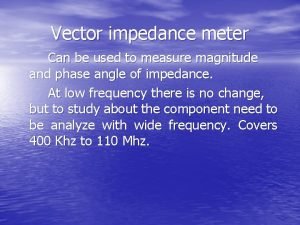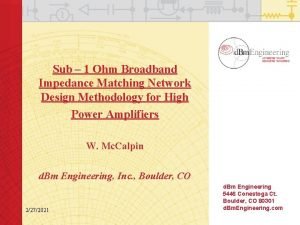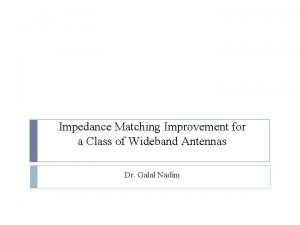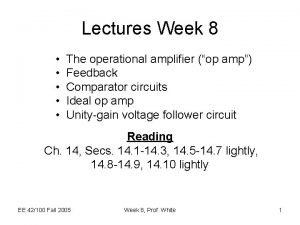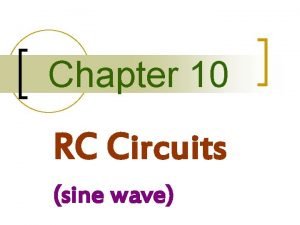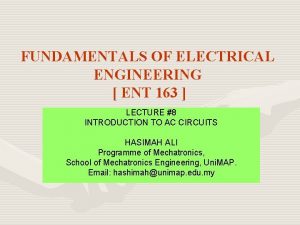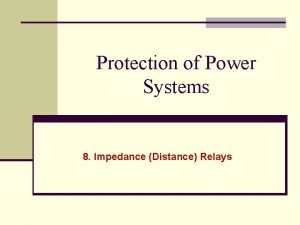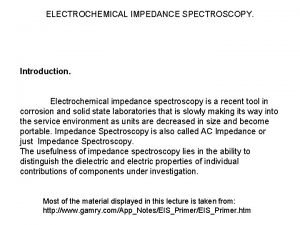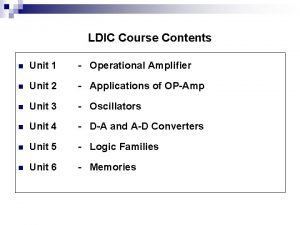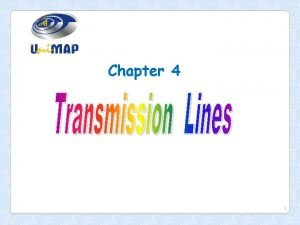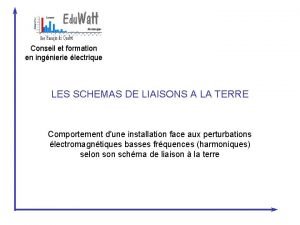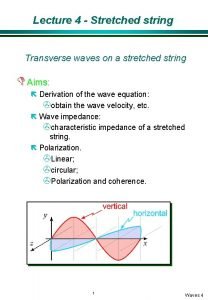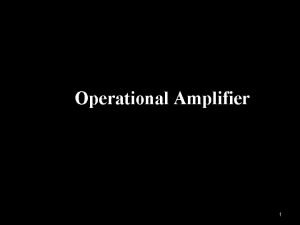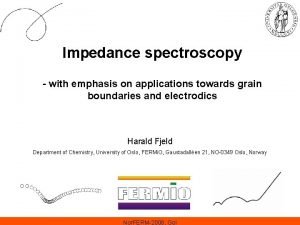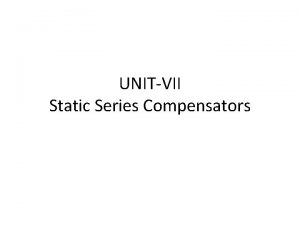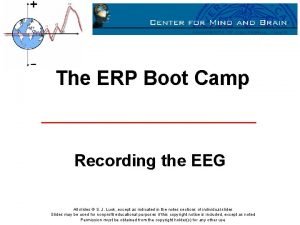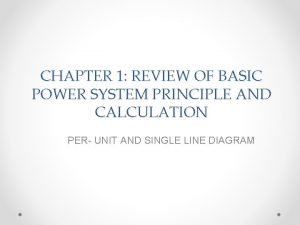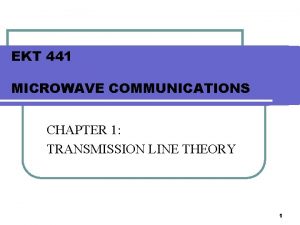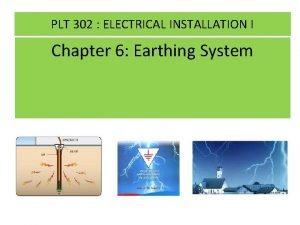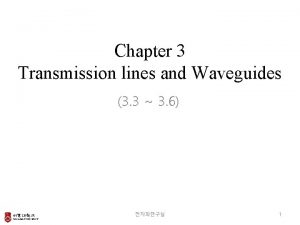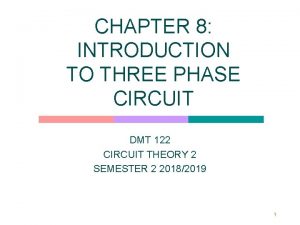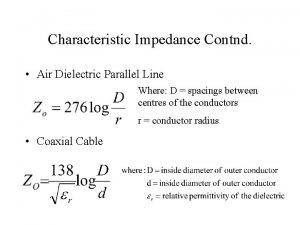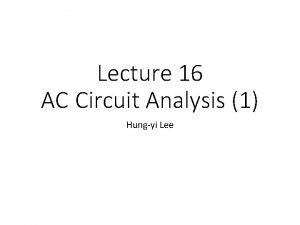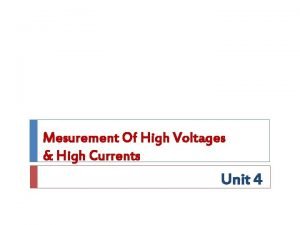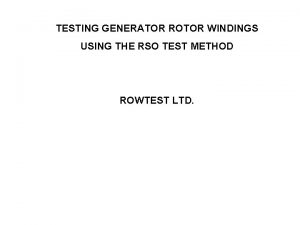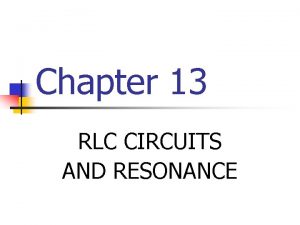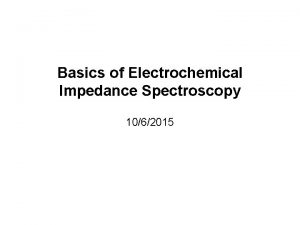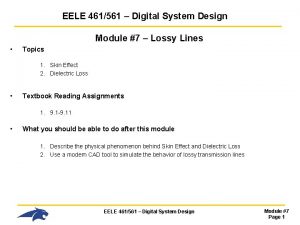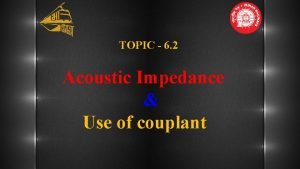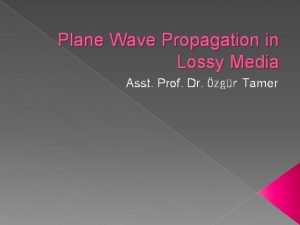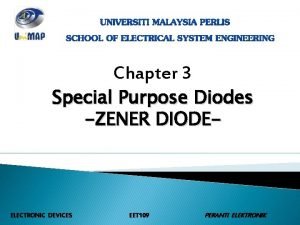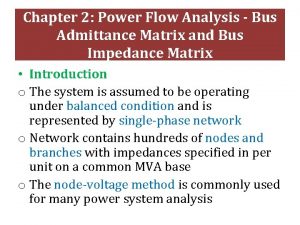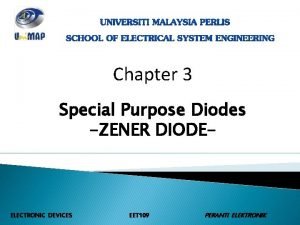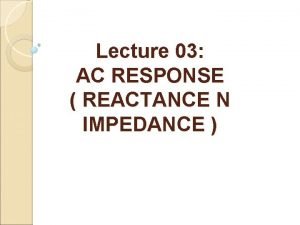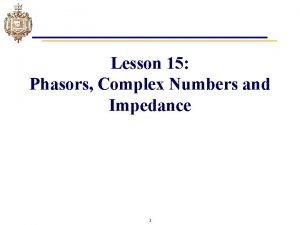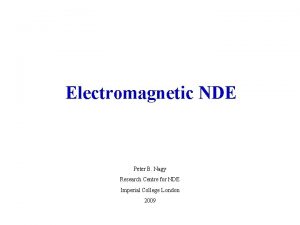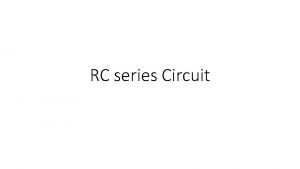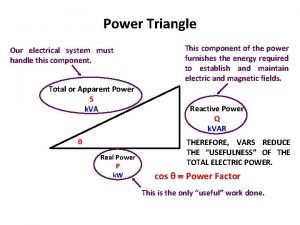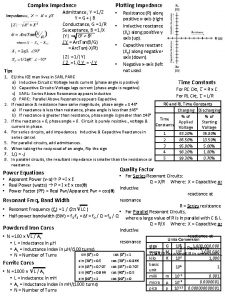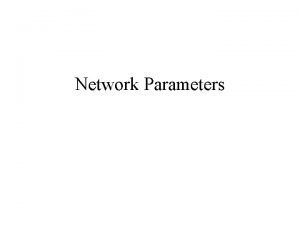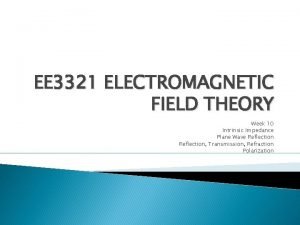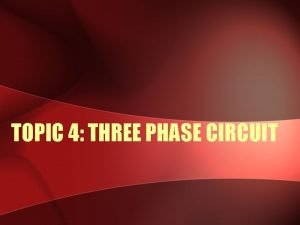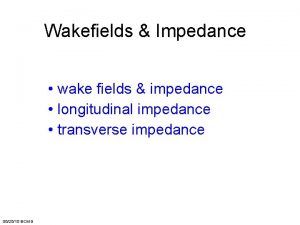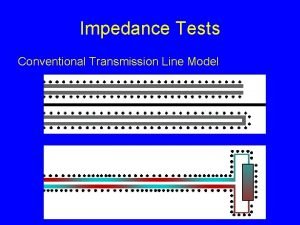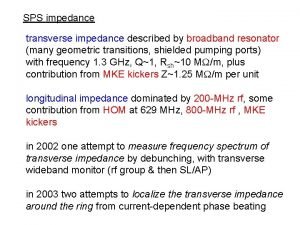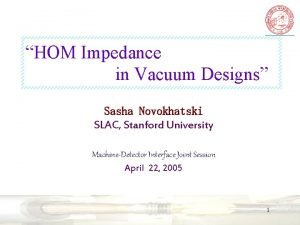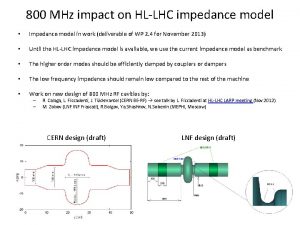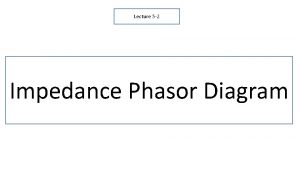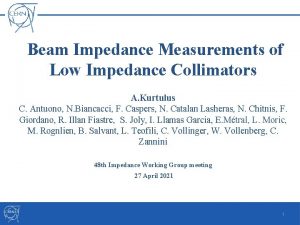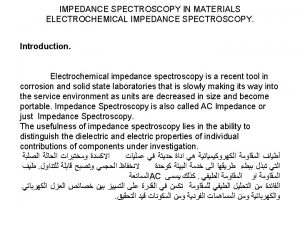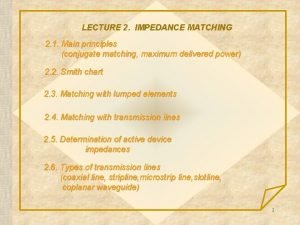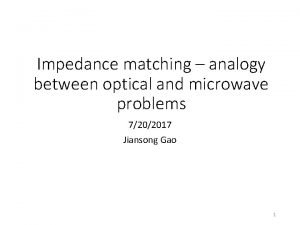IMPEDANCE Matching LOADED Q n n The Q






























































- Slides: 62

IMPEDANCE Matching

LOADED Q n n The Q of a resonant circuit was defined to be equal to the ratio of the center frequency of the circuit to its 3 -d. B bandwidth The loaded Q of a resonant circuit is dependent upon three main factors. . 1 The source resistance (Rs. (. 2 The load resistance (RL. (. 3 The component Q as defined previous.

The effect of Rs and RL on loaded Q Rs = 50 Rs = 1000

Effect of Q vs. Xp.

Maximum Power Transfer n In DC circuits, maximum power will be transferred from a source to its load if the load resistance equals the source resistance

Maximum Power Transfer n n The source (Zs), with a series reactive component of +j. X (an inductor), is driving its complex conjugate load impedance consisting of a −j. X reactance (capacitor) in series with RL. The +j. X component of the source and the−j. X component of the load are in series and, thus, cancel each other, leaving only Rs and RL, which are equal by definition. Since Rs and RL are equal, maximum power transfer

The L Network

Simple Black Box Analysis n n n Source 100 -ohm Load 1000 -ohm So, in this situation q To maximum power transfer The available power from source would be lost about 4. 8 d. B This is done by forcing the 100 -ohm source to see 100 ohms when it looks into the impedance-matching network. But how?

First Step. Simple place -j 333 -ohm capacitor is placed across the 1000 ohm load resistor n So we have n

Impledance. . n Nowthat we have an apparent series 100−j 300 -ohm impedance for a load,

To match the impledance n All we must do to complete the impedance match to the 100 -ohm source is to add an equal and opposite (+j 300 ohm) reactance in series

Summary The function of the shunt component of the impedancematching network is to transform a larger impedance down to a smaller value with a real part equal to the real part of the other terminating impedance (in our case, the 100 -ohm source. ( n The series impedance-matching element then resonates with or cancels any reactive component present, thus leaving the source driving an apparently equal load for optimum power transfer. n

For this condition:

Equation for design of the impedance -matching The quantities Xp and Xs may be either capacitive or inductive reactance but each must be of the opposite type. Once Xp is chosen as a capacitor, for example, Xs must be an inductor, and vice versa.

Example 1 n Design a circuit to match a 100 -ohm source to a 1000 -ohm load at 100 MHz. Assume that a DC voltage must also be transferred from the source to the load. The need for a DC path between the source and load dictates the need for an inductor in the series leg,

Solution

Solution (con’t) Final circuit

DEALING WITH COMPLEX LOADS n Real world input/output impledance Transmission lines, mixers, antennas, transistor and most other sources

Two Basic Approaches in Handling Complex Impedances n Absorption q To actually absorb any stray reactances into the impedancematching network itself. q This can be done through prudent placement of each matching element such that element capacitors are placed in parallel with stray capacitances, and element inductors are placed in series with any stray inductances.

Two Basic Approaches in Handling Complex Impedances n Resonance q To resonate any stray reactance with an equal and opposite reactance at the frequency of interest. q Once this is done the matching network design can proceed as shown for two pure resistances in Example 1.

Example 2 n Use the absorption approach to match the source and load shown below )at 100 MHz. (

Solution n n The first step in the design process is to totally ignore the reactances and simply match the 100 -ohm real part of the source to the 1000 -ohm real part of the load (at 100 MHz( Goal

Example 3 n Design an impedance matching network that will block the flow of DC from the source to the load in Fig. The frequency of operation is 75 MHz. Try the resonant approach.

Solution n The need to block the flow of DC from the source to the load dictates the use of the matching network

n first, let’s get rid of the stray 40 -p. F capacitor by resonating it with a shunt inductor at 75 MHz.

n Now that we have eliminated the stray capacitance, we can proceed with matching the network between the 50 -ohm load and the apparent 600 -ohm load


THREE-ELEMENT MATCHING The three-element Pi network. The three-element T network

The Pi Network n The Pi network can best be described as two “back-to-back” L networks that are both configured to match the load and the source to an invisible or “virtual” resistance located at the junction between the two networks.

n n The significance of the negative signs for −Xs 1 and −Xs 2 is symbolic. They are used merely to indicate that the Xs values are the opposite type of reactance from Xp 1 and Xp 2, respectively. q Thus, if Xp 1 is a capacitor, Xs 1 must be an inductor, and vice versa. Similarly, if Xp 2 is an inductor, Xs 2 must be a capacitor, and vice versa. They do not indicate negative reactances (capacitors. ( q Now, we have

Example 4 n Using Figure below as a reference, design four different Pi networks to match a 100 -ohm source to a 1000 -ohm load. Each network must have a loaded Q of 15.

Solution n n From

n n The Q for the other L network is now defined by the ratio of Rs to R Notice here that the source resistor is now considered to be in the shunt leg of the L network. Therefore, Rs is defined as Rp, and

n Now the complete network design

n Remember that the virtual resistor (R) is not really in the circuit and, therefore, is not shown. Reactances −Xs 1 and −Xs 2 are now in series and can simply be added together to form a single component.

n n The only constraint is that Xp 1 and Xs 1 are of opposite types, and Xp 2 and Xs 2 are of opposite types. Therefore, to perform the transformation from the dual-L to the Pi network, the two series components are merely added if they are alike, and subtracted if the reactances are of opposite type.

n Which one to choose? q Depend on any number of factors including: . 1 The elimination of stray reactances. . 2 The need for harmonic filtering. . 3 The need to pass or block DC voltage.

The T network n The design of the 3 -element T network is exactly the same as for the Pi network except that with the T, you match the load and the source, through two L-type networks, to a virtual resistance that is larger than either the load or source resistance. This means that the two L-type networks will then have their shunt legs connected together

Q value of T n since we have reversed or “flip-flopped” the L sections to produce the T network, we must also make sure that we redefine the Q formula to account for the new resistor placement, in relation to those L networks.

Example 5 n Using Figure below as a reference, design four different networks to match a 10 -ohm source to a 50 -ohm load. Each network is to have a loaded Q of 10.

Solution n we can find the virtual resistance we need for the match n From previously, n Now, for the L network on the load end, the Q is defined by the virtual resistor and the load resistor. Thus,

Solution

THE SMITH CHART n The chart was originally conceived back in the 1930 s by a Bell Laboratories engineer named Phillip Smith, who wanted an easier method of solving the tedious repetitive equations that often appear in RF theory

Smith Chart Construction n Step 1: The reflection coefficient of a load impedance when given a source impedance can be found by the formula: n In normalized form, this equation becomes: n where Zo is a complex impedance of the form R+j. X

n The polar form of the reflection coefficient can also be represented in rectangular coordinates: n So, we have n If we draw the family of curves we have:

Two families of smith chart

Combined Together

Basic Smith Chart Tips: Important n n n All the circles have one same, unique intersecting point at the coordinate (1, 0). The zero circle where there is no resistance (R=0) is the largest one. The infinite resistor circle is reduced to one point at (1, 0). There should be no negative resistance. If one (or more) should occur, you will be faced with the possibility of oscillatory conditions. Another resistance value can be chosen by simply selecting another circle corresponding to the new value.

Plotting Impedance Values 1+j 1 1 -j 1

Let try to read this

Example n If Z =0. 5+j 0. 7 ohm. q Series capacitive reactance of –j 0. 7

Add Inductance

Remember n n Series capacitive reactance move downward Series inductor move upward

Conversion of Impedance to Admittance n n n Convert any impedance (Z) to an admittance (Y), and vice versa. This can be accomplished by simply flipping the Smith Chart over. it can be extremely useful in designing match networks with components like series or shunt inductors and capacitors A shunt inductor causes rotation counter-clockwise along a circle of constant admittance. So, a series capacitor, added to a load, causes rotation counter-clockwise along a circle of constant resistance, while a shunt capacitor causes rotation clockwise along a circle of constant admittance.

Amittance VS Impledance n n an admittance is simply the inverse of an impedance where the admittance (Y) contains both a real and an imaginary part, similar to the impedance (Z).

Circuit representation for admittance.

Example n Impedance Z =1+j 1.

Notice that the two points are located at exactly the same distance (d) from the center of the chart but in opposite directions (180◦) from each other.

Impedance and Admittance coordinates,

Admittance Manipulation on the Chart we begin with an admittance of Y =0. 2−j 0. 5 mho and add a shunt capacitor with a susceptance )reciprocal of reactance) of +j 0. 8 mho.


 Vector impedance meter block diagram
Vector impedance meter block diagram Oval window and round window
Oval window and round window Wideband impedance matching
Wideband impedance matching Macula in ear
Macula in ear Wideband impedance matching
Wideband impedance matching Differential amplifier
Differential amplifier Hematology
Hematology Impedance threshold device
Impedance threshold device Sinusoidal response of rc circuit
Sinusoidal response of rc circuit Ent 163
Ent 163 Impedance relay
Impedance relay Electrochemical impedance spectroscopy
Electrochemical impedance spectroscopy Ic 741 has i/p impedance of 2mq.
Ic 741 has i/p impedance of 2mq. Vswr formula
Vswr formula Capacitor laplace
Capacitor laplace Couplage par impédance commune
Couplage par impédance commune Transverse impedance of a string
Transverse impedance of a string Acoustic impedance
Acoustic impedance Op amp gain bandwidth product
Op amp gain bandwidth product What is impedance
What is impedance The effective capacitive impedance of a gcsc
The effective capacitive impedance of a gcsc Skin electrode impedance
Skin electrode impedance Impedance threshold device
Impedance threshold device Per unit equations
Per unit equations Attenuation constant formula
Attenuation constant formula Earth loop impedance
Earth loop impedance This impedance (z = 5 - j11) represent:
This impedance (z = 5 - j11) represent: Rectangular waveguide impedance
Rectangular waveguide impedance Introduction to three phase system
Introduction to three phase system Characteristic impedance of air
Characteristic impedance of air Impedence triangle
Impedence triangle Charge transfer resistance
Charge transfer resistance Series impedance voltmeter
Series impedance voltmeter Valvulo arterial impedance
Valvulo arterial impedance Transvalvular gradient
Transvalvular gradient Line current and phase current
Line current and phase current Rso test
Rso test Vc
Vc Electrochemical impedance spectroscopy basics
Electrochemical impedance spectroscopy basics Characteristic impedance definition
Characteristic impedance definition Acoustic impedance of steel
Acoustic impedance of steel An example for lossless propagation is___________________.
An example for lossless propagation is___________________. Izk zener diode
Izk zener diode Y bus admittance matrix
Y bus admittance matrix Special diode
Special diode What is total impedance
What is total impedance Eli the ice man
Eli the ice man Monopole dipole
Monopole dipole Rc series circuit diagram
Rc series circuit diagram Power triangle diagram
Power triangle diagram Y=1/z impedance
Y=1/z impedance Abcd matrix transmission line
Abcd matrix transmission line Define intrinsic impedance
Define intrinsic impedance Line vs phase voltage
Line vs phase voltage How op amp works
How op amp works điện thế nghỉ
điện thế nghỉ Một số thể thơ truyền thống
Một số thể thơ truyền thống Nguyên nhân của sự mỏi cơ sinh 8
Nguyên nhân của sự mỏi cơ sinh 8 Trời xanh đây là của chúng ta thể thơ
Trời xanh đây là của chúng ta thể thơ Ng-html
Ng-html Các số nguyên tố là gì
Các số nguyên tố là gì Thiếu nhi thế giới liên hoan
Thiếu nhi thế giới liên hoan Vẽ hình chiếu vuông góc của vật thể sau
Vẽ hình chiếu vuông góc của vật thể sau
